Question
Question 4 This problem is an extension of Chapter 8. I am assuming this is the first time you have seen a problem like this.
Question 4
This problem is an extension of Chapter 8. I am assuming this is the first time you have seen a problem like this. You can find more detailed information in Chapter 9, but it is not required.
A hypothesis test in statistics is a way to bring evidence for or against a certain statement using probability theory.
For this question, we will assume the Null Hypothesis is the following statement:
"Our jump program is guaranteed to increase your vertical jump by a minimum of 9 inches."
In a hypothesis test, you will have another statement which is, literally, the opposite of the null hypothesis (called the Alternate Hypothesis):
"The program is not guaranteed to increase a team's vertical jump by a minimum of 9 inches, on average."
This can be re-stated as:
"The program's average vertical jump increase is actually less than 9 inches."
Here's how to conduct the test at the 1% significance level (=0.01=0.01, C.L.=0.99C.L.=0.99):
Step 1: Compute the Margin of Error for a confidence interval again, this time for a 98% confidence interval. Yes, use 98 instead of 99. We will discuss why we need to do this in more detail later.
Step 2: Produce a 98% confidence interval.
But there is a caveat: Unlike the confidence interval the you produced in Question 3 (a), you will center the interval at 0=90=9 instead of at the sample mean. Using the Margin of Error that you produced in Step 1, the interval should now look like:
(0M.E.,0+M.E.)(0M.E.,0+M.E.)
Step 3: Decide if the sample mean, x, is inside the interval produced in Step 2 or outside this interval.
If the sample mean is inside the interval, you have no evidence to reject the null hypothesis:
Conclusion: Fail to Reject the Null Hypothesis at the 1% significance level
If the sample mean is outside the interval, you have evidence to reject the null hypothesis.
Conclusion: Reject the Null Hypothesis at the 1% significance level.
Step 4: Report the p-value.
To do this, we will assume that
N(0,)XN(0,n)
If is known, then the p-value is given by:
(<)=(<0)P(X Unfortunately, is not usually known. So, we use s instead (s is a point estimate for ) But, since s can vary from sample to sample, we use an approximation for the p-value: (<)(<0)P(X This requires a T-table. Go ahead and find the p-value. Step 5: State the reasoning for your conclusion: If the null hypothesis is true (if the jump program really does increase a team's vertical by a minimum of 9 inches, on average) and we put a different group of 22 volleyball players through the same protocols... Then there is a chance, equal to the p-value, that the new group's average vertical jump increase is LESS than what we have observed in the current group. Re-write this statement using the p-value that you found and the sample mean that you computed from Question 1. Note that a high p-value, compared to 1%, corresponds to the conclusion: FAIL TO REJECT Note that a low p-value, compared to 1%, corresponds to the conclusion: REJECT Referring to Question 4 (Step 4): (a) Make a sketch of the probability distribution under the assumption that the null hypothesis is true. This sketch should look almost identical to your sketch from Question 2, except the center of the distribution will differ. (b) Shade in the area that corresponds to the p-value.
Step by Step Solution
There are 3 Steps involved in it
Step: 1

Get Instant Access to Expert-Tailored Solutions
See step-by-step solutions with expert insights and AI powered tools for academic success
Step: 2

Step: 3

Ace Your Homework with AI
Get the answers you need in no time with our AI-driven, step-by-step assistance
Get Started


